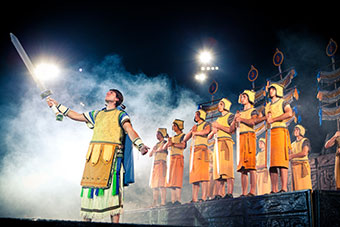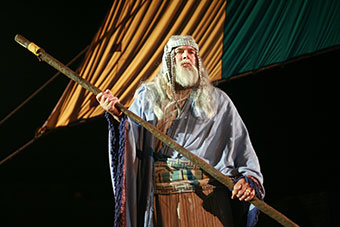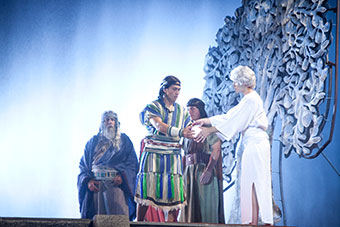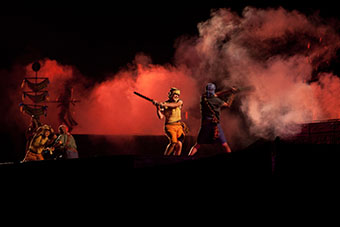The Sacred Stage
by Charlotte Hsu

The Hill Cumorah Pageant, held yearly on a grassy slope outside of Rochester, may be the only place you’ll ever see a Mormon dad in clip-on earrings and a shoulder-length wig.
On warm July nights beneath the stars, the production unfolds on eight connected stages, with actors braving fireballs and artificial rain to perform scenes from the Book of Mormon, a sacred text.
Water cannons fire. Thunder booms through colossal speakers. A man portraying Jesus Christ descends from the heavens, hooked to a fly system 70 feet above the audience.
It’s a hell of a show.
Billed as America’s longest-running outdoor religious drama, the Hill Cumorah Pageant brings Mormon scripture to life in a way you’ve never seen it before.


Part of the spectacle’s mystique is its setting. The Hill Cumorah, some 20 miles southeast of Rochester, is the birthplace of the Mormon religion—the very spot where the prophet Joseph Smith is said to have received the words of the Book of Mormon from an angel in 1827.
The shop that printed the sacred tome’s first copies is a five-minute drive away, in the town of Palmyra.
The pageant, which celebrates its 75th anniversary this summer, invites believers and nonbelievers alike to revisit these oft-forgotten events in Upstate New York history.
While the show draws a mostly Mormon crowd, everyone is welcome, said Christopher Bjorling, second counselor in the pageant presidency and one of the production’s organizers.
“We have friends bringing friends,” he said. “We have tour groups, tour buses.”
“You don’t need to know anything about Mormonism, about the pageant, to go and enjoy it,” said Jerry Argetsinger, a playwright and theater professional who directed the performance for eight years in the 1990s.
The show—which is parodied in scenes in Broadway’s Book of Mormon musical—embodies the strait-laced, can-do culture of the Mormon church: It’s extravagant, yet fervently spiritual, and run completely by volunteers.
It is, in a manner, totally outrageous—an artistic binge with a cast of more than 700, some of who play multiple characters.
One actress, sharing memories on a blog commemorating the pageant’s 75th year, described her experience this way: “I was a Nephite Dancer and a Destruction Stunt Victim. I got to die in an incredibly dramatic way that included a giant fireball and leaping down a short flight of stairs and tumbling to the ground. It was great!”
On pageant nights, spectators amass by the thousands on the lawn below the hillside, flopping down on picnic blankets or taking a seat in steel-framed chairs. Vendors sell burgers, hot dogs, chicken dinners, salads, salt potatoes, and fruit. Lemonade is available. (No wine or beer—this is, after all, a Mormon party.)
For two hours before the performance, actors roam the grounds in wardrobe, greeting early arrivals. Missionaries circle as well, sharing information about the Mormon church, the Church of Jesus Christ of Latter-Day Saints (LDS).
Then it’s time for the show.
•
The Hill Cumorah Pageant wasn’t always so grand.
In its first year, 1937, missionaries staged the show with only headlights for illumination, said Argetsinger, who penned a history of the pageant for the Journal of Book of Mormon Studies.
The article chronicles the production’s growth, recounting how it grew ever more flamboyant as legions of Mormon volunteers donated time and talent.
What It’s Like to Be in the Pageant
Dan and Trish Alessi from West Seneca performed in the Hill Cumorah Pageant in 2005 with their daughters, Ashley Noall and Hannah, Amanda and Jessica Alessi, ages 12 to 22.
Rehearsals begin about a week before opening night. It’s not until then that cast members learn their roles and meet one another for the first time, the Alessis said.
Each day of practice, the cast met for director’s notes, singing and a spiritual thought. Between rehearsals, adults supervised groups of children and teens, overseeing activities like games and trips to local Mormon history sites.
Though some families stayed in local college dorms or camped on lawns by the Hill Cumorah, the Alessis rented a trailer. They ate cereal and fruit each morning, and home-cooked meals at night.
During the pageant, Trish and Jessica acted as dancers. Amanda was a daughter of a prophet’s son, and Dan was a servant to the wicked king Noah. Ashley and Hannah, now 12, played extras: “I was five years old then, so they had me run up on Jesus’s lap,” Hannah remembers.
“It was just a good family experience,” said Hannah, who emailed pageant organizers recently to ask if she could participate again. She found out that she can’t sign up because she’s underage, but she’s still hoping for a repeat experience: “I’m always bugging my parents to go again.”
Famed Mormon composer Crawford Gates scored music, which was recorded by groups including the Mormon Tabernacle Choir. Other professionals within the church wrote the script, built sets, and crafted publicity.
In 1991, the show became a community affair, with local groups like the Rotary and Lions clubs invited to sell snacks and meals to crowds to raise money.
The pageant in its current form owes much of its glitz and grandeur to the work of Argetsinger’s wife, Gail. A costume designer at SUNY Brockport, she was called upon by the church to outfit the cast in 1980.
The pageant tells a story that opens in 600 BC, when God commands a prophet named Lehi to flee Jerusalem for a promised land, the Americas, where his people can lead a righteous life. Lehi’s sons make the voyage and establish two nations of people, the Nephites and Lamanites, who forget their roots and grow wicked with time.
To paint these scenes, Gail studied the dress of ancient American civilizations, even traveling to Washington, DC to browse the Smithosonian Museum’s private collections of feathered capes, Aymara weavings, and other artifacts.
From her hands and her imagination, a world of characters bloomed—crowned kings, leather-clad armies, dancers draped in brass and gold.
“I had a group of friends who would come over to my house, and we would cut out the costumes and package them with explicit instructions, with all of the pieces and the details and doodads that got sewed on them and everything,” she recalls. “[These instructions] got shipped off to congregations throughout the Eastern United States.”
The wardrobe, like the play itself, was a jewel box of color. The details were whimsical, the vision grand. When a local family donated antlers, Gail converted the horns into headgear. Barbara Williams, a colleague, crafted wigs and beards by hand.
Though Gail concluded her pageant work in 1997, her designs, with all their flourishes, set the tone for future productions. In all, she created more than 3,000 costumes.
“It’s just a beautiful, spectacular show,” she said.
•
In contrast to the pageant, the Hill Cumorah is a humble monument.
A flight of concrete steps climbs to the top, leading visitors to a bronze statue of the angel Moroni, which crowns a pillar of snow-white granite.
One of the memorial’s most moving parts is the view—a sprawling panorama of farms, fields, and verdant forests. From this quiet land, the Mormon church radiated outward, moving westward as it gained new converts.
The religion did not spread peacefully; as Mormons grew in number and political power, they became the target of raids by neighbors and vigilantes. After Smith was killed by a mob in Illinois in 1844, a church leader named Brigham Young led the Mormons west to Utah.


The first group of believers reached the Great Salt Lake Valley on July 24, 1847, which Mormons celebrate as Pioneer Day.
The Hill Cumorah Pageant is one of many LDS festivities that occur around this time each year. The event is a homecoming of sorts for the thousands of Mormons who travel from afar to attend.
“It’s kind of like visiting St. Peter’s in Rome—it’s a sense of pilgrimage,” said Jerry Argetsinger. “You feel like you’ve been someplace special and have witnessed an exciting show.”
The spirituality that surrounds the pageant is one thing that has never changed, even as the script and score and special effects have evolved.
The entire cast comprises Mormon families who travel on their own dime to perform in the show. Casting and rehearsals begin just a week before opening night, but even with all that needs to be done, each day includes two devotionals, during which actors read scripture and sing hymns.
Many participants say their favorite part of the pageant is the scene when Jesus Christ, resurrected, visits the Nephites and Lamanites in 34 AD.
“It just felt so real, like you were really there,” said Trish Alessi, of West Seneca, who performed in 2005 with her husband and four daughters. “It was just so powerful.”
“The Book of Mormon is one of my favorite books in the world,” said Gail Argetsinger, the costume designer. “It tells a fantastic story of conflict between good and evil people who are struggling to do the best they can, and who are looking forward to the coming of Christ.
“And then he visited them,” she continued, a note of reverence in her voice. “And I really believe that.”
Opening night this summer is July 13.
You’re invited.
Late that evening, the sky will darken. Lights will illuminate the Hill Cumorah. The audience, sprawled at the foot of the slope, will go quiet.
And, as it has each summer for nearly 75 years, the pageant will begin.
•
Hill Cumorah Pageant
July 13-14 and 17-21 at 9pm. 603 State Route 21, Palmyra, NY. Free and open to the public. hillcumorah.org/Pageant.
blog comments powered by Disqus|
Issue Navigation> Issue Index > v11n28 (Week of Thursday, July 12) > The Sacred Stage This Week's Issue • Artvoice Daily • Artvoice TV • Events Calendar • Classifieds |









 Current Issue
Current Issue